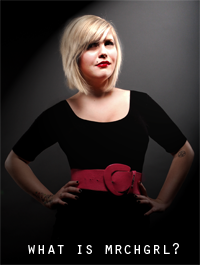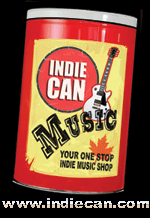There are a lot of variables that go into making a t-shirt that will sell. Most bands that are starting out don't have the budget available to hire a professional graphic designer and in most cases they have friends or people in the band who are capable of doing a quality design. However, there are many things to consider when designing for merchandising. Here are some of them;
fashion_vs.marketing
When designing a t-shirt, what should be the most important factor?
Whether or not it will sell.
If you can't sell your t-shirt, or you don't sell as many as you could be, then you're basically turning money away. So ask yourself, when you are shopping for a t-shirt what is it that you're looking for? Something that has a label sprawled across it or something that is eye catching and has substance? And when you buy a shirt to support the band do you wear it as much as you could instead of those eye-catching substance-having shirts you bought at the store? And if a band you love has several shirts and one of them just has their name on it, and the other two have wicked designs, which one do you think you would buy (given that they were the same price?)
Not everything that is made cheap has to look cheap and its about using the skills and tools available to you to make it so.
So what are the things that make a shirt eye-catching and substance-having?
For starters, they don't need to look like affliction tees. I would recommend thinking of your favourite bands, or bands you kinda sound like, even, and visiting their websites to see what kind of shirts they are selling. If you're a metal band, chances are the bands in your genre will have large, colourful and dark images with lots of big lettering and the bands name across it. Not much has changed in Metal merch in the last several years. Now, mainstream and indie merch? That's a different story.
here is an example of a shirt that if it were a new band on the scene probably wouldn't sell as much as these guys do. (probably not even close)here is an example of a shirt (tegan & sara) that uses graphics instead of branding to sell to an audience that is fashion-conscious.
It still all depends on the genre, but in most cases mainstream and indie merch is either taking trends from fashion or sending them into fashion. The most common among indie and d.i.y. artists are indie/d.i.y. style shirts, meaning sketches or cut-out letters or something a bit obscure (Artists like: Death Cab for Cutie, Feist, Metric). More electronic artists are using symbolism and patterns (Artists like: M.I.A., MSTRKRFT, Justice) and mainstream Rock/Pop artists are finding their ways between the two. It's important to really grasp what your genre is so that you can understand your market. Now, obviously if your band has a very different sound and style then that should be reflected in the shirts you sell, shouldn't it?
Throwing the bands' name across the front of the shirt, although it worked for a long time, just doesn't cut it anymore. People (en masse) are generally more concerned with how they look then which bands they like (although those two things often walk hand in hand) and if your merchandise doesn't follow those patterns, it'll be impossible to having your fans wearing your stuff.
Merch is a tool that bands use to make money. But what is often failed to be realized early in the game is the fact that your merch is also a tool to help you create more sales. It is billboard sent out into the world to promote your band. If a shirt is being worn on someone who supports your music and another person sees it and is caught by its appeal, they are going to ask about it and often get information that is crucial to spreading the word about your music.
If your main fan base is made up of 14-19 year old girls, then chances are they aren’t going to want a gargoyle howling at the full moon on the edge of a cliff looking over a great body of water. However, find the right font for your bands name and you’ve got yourself a pretty rad Metal shirt.
Doing research plays a significant role in creating a long-lasting business and if you want to go somewhere in the vein of professionalism with your band, that’s exactly how you have to look at it, as your business.
Look at where the trends are going in fashion, pay attention to styles of screen printing that are more popular. If all the girls in your audience are wearing baby blue tees with hearts and gumdrops and cupcakes all over them, then chances are if you design a shirt in a similar style they are going to eat it up. Throw that same shirt at kids at a punk show and they will probably make you eat it. (Use a fork and knife; it’ll be faster and easier to chew that way!)
quantity_ vs. quality
When it comes to deciding on the amount of money you’re willing to spend on an early run of tees, keeping in mind things like colors and amount of t-shirts to be ordered is a big deal. There are little things you can do during the process to give fans more incentive to purchase a shirt from your band.
It costs the same amount of money to print an ugly design as it does to print a good one.
A screen printer isn’t going to tell you if your design is good or bad, they are just going to take your money, print your t-shirts and send the job on its way. They aren’t going to think twice about whether or not your shirts will sell and if you’ll be making another order because 80% of the time bands don’t reorder (chances are it’s because they made crappy shirts and can’t sell them all!)
It is up to you (or your band) to decide what print is best for you and how it’s going to sell, so here are a couple of tips and tricks to get an idea of where to start:
- throw up a couple of merch designs on your blog / website / myspace and have your fans comment on which ones they like best. Chances are they will all get some love, but there is usually one that gets a lot more attention and that is usually the one that should be getting done. You can always keep the other designs and use them at a later time
- ask your friends which t-shirts they have that they love the best and why
- hold a design contest with your fans and get them to design tshirts for your band and vote on them, the design with the most votes wins and you get a free design (this one is best offered with a free tshirt and a bit of money to the fan who designs the winner)
Another extremely important thing when it comes to the quality of the t-shirt is its style. The style of a t-shirt is basically how it fits and how it looks on, also often how it washes and wears. Guys are often a bit easier in this case and will wear just about anything, but as fashion becomes a more prominent factor in the music scene that will change and they will become less indiscriminate, so it’s important to factor that in now. Women are a lot more particular about how their clothing fits them, so paying attention to what is happening in fashion also allows you to see what kind of garments and styles you should be printing on. Right now ladies prefer longer, lighter fabric with a soft feel and the ability to wash. Men also prefer a bit of a longer, more fitted tee (genre-specific) and are more discriminating about fit. Good options for wholesaling are the ladies Gaziani (available through most screen printers and distributors) 5562 Junior Fit Tee. Although American Apparel tees are the best known for quality t-shirts, they fit a bit short and often shrink and are significantly more expensive than most wholesale t-shirts. A Men’s Alstyle AAA Platinum Tee (item #1701 in Alstyle Apparel) is a bit of a heavier, yet soft style fit and fits a bit longer also.
Taking into consideration style, fit and print, getting an early batch of t-shirts printed can be a nightmare, but if you choose a screen printer that is dependable and honest, you should be able to achieve selling out your batch.
designing_ for screen printing
When creating a new t-shirt style for sale, a graphic designer is often brought in to do the job. The problem is, most graphic designers have little-to-no clue all of the factors that go into screen printing and thus offer up beautiful, but un-printable (or incredibly expensive) designs. There are many ways to make designs that are both easy and inexpensive to print.
Colour plays a very important part of a t-shirt design; however it isn’t the most important part. If you look at t-shirts in department stores, most are only 1,2 or 3 colour prints because they are mass-distributed. Limiting your colour range doesn’t have to limit the sell-ability of your t-shirts. Larger images and graphics without letters are both inexpensive and aesthetically pleasing (and trendy!)
Using things like halftones can aid you in creating one-colour prints while still getting lots of detail and photo-real images.
So when you’re looking for a designer to make your t-shirt designs, make sure that they have experience designing for t-shirt printing specifically.
cutting_ costs
Yet another factor that plays a major role in the success of a t-shirt is how much it costs. In order for something to be cheap to sell, it has be to cheap to make. That sounds like it’s contrasting my previous statement about quality t-shirts, but there are ways to make less expensive t-shirt designs and prints that are great without breaking the bank. As previously mentioned, using a graphic designer with experience in screen printed t-shirts will allow them to provide you with limited colour designs that are screen-printer friendly.
Ordering less t-shirts to start off with is also pivotal, you don’t need to order 100 t-shirts instead of 50 because you’ll be saving $1.00 on the cost of printing. Start off with fewer pieces and increase your orders as they sell and your fan base grows. Discuss your screen-printers policies on screens and how long they keep them, often you can re-order t-shirts without paying screen fees again, or just incurring minor set up costs.
Use one-stop-shops like Mrchgrl. (Innocent plug!) When you want to have your t-shirts made, using a one-stop-shop allows you to customize your experience and order directly without dealing with all of the hassle, and often you save money because you are going to the same place for all of the services required.
sales_
One thing that is severely overlooked when creating a merchandising plan is who is going to be selling your merchandise at your shows. This may sound like an insignificant detail but having someone who is your buddy from high school sell your merch sends out a message to your fans as well as professionals in the industry that you aren’t a professional band. It may save you a few bucks, but it probably costs you sales.
Hiring someone who is knowledgeable about merchandising, your band and how to sell merch could help seriously boost sales. Fans have questions about the band and about the merch and “I dunno” or “wait until the drummer gets here, you can ask him” don’t exactly give off a vibe of confidence. Your merch table is basically a rolling store and if treated in the right manner can be another tool for you to use to your advantage.
That is the end of today’s lesson!
Your homework: Research similar bands to you and look at the kind of merch they are selling. Make notes about the styles that strike you and what about them strikes you. Rinse and repeat.








No comments:
Post a Comment